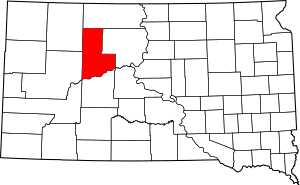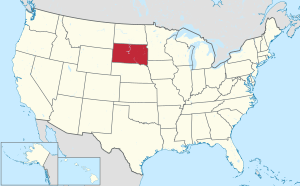Ziebach County, South Dakota facts for kids
Quick facts for kids
Ziebach County
|
|
|---|---|

Ziebach County Courthouse
|
|

Location within the U.S. state of South Dakota
|
|
 South Dakota's location within the U.S. |
|
| Country | |
| State | |
| Founded | 1911 |
| Named for | Frank M. Ziebach |
| Seat | Dupree |
| Largest city | Dupree |
| Area | |
| • Total | 1,971 sq mi (5,100 km2) |
| • Land | 1,961 sq mi (5,080 km2) |
| • Water | 9.3 sq mi (24 km2) 0.5% |
| Population
(2020)
|
|
| • Total | 2,413 |
| • Estimate
(2023)
|
2,322 |
| • Density | 1.2243/sq mi (0.47269/km2) |
| Time zone | UTC−7 (Mountain) |
| • Summer (DST) | UTC−6 (MDT) |
| Congressional district | At-large |
Ziebach County is a county in the U.S. state of South Dakota. As of the 2020 census, the population was 2,413. Its county seat is Dupree. It is the last county (or county equivalent) in the United States alphabetically.
Ziebach County consists entirely of indian reservations. Most of the county is within the Cheyenne River Indian Reservation and the remainder is within the Standing Rock Indian Reservation. The county's per-capita income makes it the fourth-poorest county in the United States.
Contents
History
A county named Ziebach was created in Dakota Territory in 1877. However, after South Dakota became a state, this county was dissolved in 1898 and its areas absorbed by Pennington and Stanley counties. The present Ziebach County was created by the SD Legislature on February 1, 1911, and was fully organized by April 22. The 1911 Ziebach County encompassed parts of the former counties of Schnasse, Armstrong and Sterling, which were the last three extinct counties of South Dakota to cease to exist. It was named for Frank M. Ziebach, a political figure in the Dakota Territory during the territorial period from 1861 to 1889. Previously the area had been used by trappers and in 1907 part was briefly a reservation for Ute Indians displaced from Utah and Wyoming. Early in the 20th Century cattle were raised in substantial numbers, but when the railroad bypassed the area this industry declined. Limited homesteading also occurred on the more fertile lands.
Geography
The Cheyenne River flows east-northeastward along the southern boundary of Ziebach County. The Moreau River flows eastward through the upper portion of the county, and Cherry Creek flows southeastward through the lower portion, draining the area into the Cheyenne River. The terrain is composed of semi-arid rolling hills interrupted by buttes and carved by drainages and gullies, partly devoted to agriculture and cattle. The terrain slopes to the south and the east; its highest point (except for the isolated Thunder Butte, at 2,733') is near its NW corner at 2,582 ft (787 m) ASL. The county has a total area of 1,971 square miles (5,100 km2), of which 1,961 square miles (5,080 km2) is land and 9.3 square miles (24 km2) (0.5%) is water. Almost the entire county lies within the Cheyenne River Indian Reservation. The balance of the county, along its extreme northern county line, lies within the Standing Rock Indian Reservation. It is one of five South Dakota counties that are composed entirely of land that is within the boundaries of Indian reservations.
Buttes
Ziebach County is part of the Great Plains and is characterized by rolling grasslands and numerous buttes. The buttes form the highest points of elevation in Ziebach County:
- Bessie Butte 2,474 feet (754 m)
- Eagle Butte 2,484 feet (757 m)
- Gray Butte 2,316 feet (706 m)
- High Elk Hill 2,395 feet (730 m)
- Joshua Butte 2,165 feet (660 m)
- Marple Butte 2,484 feet (757 m)
- Mud Butte 2,500 feet (760 m)
- Mud Butte 2,365 feet (721 m)
- Rattlesnake Butte 2,411 feet (735 m)
- Saint Patrick Butte 2,356 feet (718 m)
- Squaw Teat Butte 2,365 feet (721 m)
- Thunder Butte 2,733 feet (833 m)
Major highways
Adjacent counties
- Corson County - north
- Dewey County - east
- Stanley County - southeast
- Haakon County - south
- Pennington County - southwest
- Meade County - west
- Perkins County - northwest
Protected areas
- Bednor Lake State Game Production Area
- Cheyenne State Game Production Area (part)
- Grand River National Grassland (part)
Lakes and reservoirs
- Bedners Dam
- K C Dam
- Rattlesnake Lake
Demographics
| Historical population | |||
|---|---|---|---|
| Census | Pop. | %± | |
| 1920 | 3,718 | — | |
| 1930 | 4,039 | 8.6% | |
| 1940 | 2,875 | −28.8% | |
| 1950 | 2,606 | −9.4% | |
| 1960 | 2,495 | −4.3% | |
| 1970 | 2,221 | −11.0% | |
| 1980 | 2,308 | 3.9% | |
| 1990 | 2,220 | −3.8% | |
| 2000 | 2,519 | 13.5% | |
| 2010 | 2,801 | 11.2% | |
| 2020 | 2,413 | −13.9% | |
| 2023 (est.) | 2,322 | −17.1% | |
| U.S. Decennial Census 1790-1960 1900-1990 1990-2000 2010-2020 |
|||
2020 census
As of the 2020 census, there were 2,413 people, 732 households, and 528 families in the county. The population density was 1.2 inhabitants per square mile (0.46/km2). There were 882 housing units.
2010 census
As of the 2010 census, there were 2,801 people, 836 households, and 638 families in the county. The population density was 1.4 inhabitants per square mile (0.54/km2). There were 987 housing units at an average density of 0.5 per square mile (0.19/km2). The racial makeup of the county was 74.9% American Indian, 21.8% white, 0.2% black or African American, 0.1% Asian, 0.1% from other races, and 3.0% from two or more races. Those of Hispanic or Latino origin made up 3.1% of the population.
Of the 836 households, 53.7% had children under the age of 18 living with them, 39.0% were married couples living together, 29.3% had a female householder with no husband present, 23.7% were non-families, and 20.9% of all households were made up of individuals. The average household size was 3.35 and the average family size was 3.82. The median age was 25.4 years.
The median income for a household in the county was $27,578 and the median income for a family was $22,857. Males had a median income of $28,954 versus $24,327 for females. The per capita income for the county was $11,069. About 41.9% of families and 46.0% of the population were below the poverty line, including 56.1% of those under age 18 and 22.9% of those age 65 or over.
Communities
Cities
- Dupree (county seat)
- Eagle Butte (partial)
Census-designated places
- Bridger
- Cherry Creek
Unincorporated communities
- Chase
- Glad Valley
- Iron Lightning
- Red Elm
- Red Scaffold
- Thunder Butte
Unorganized territories
Ziebach County government does not include subdivision into townships. The county is divided into three areas of unorganized territory: Dupree, North Ziebach, and South Ziebach.
See also
 In Spanish: Condado de Ziebach para niños
In Spanish: Condado de Ziebach para niños

